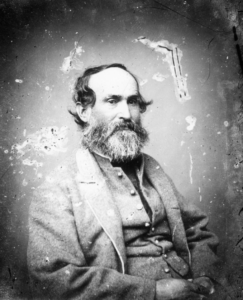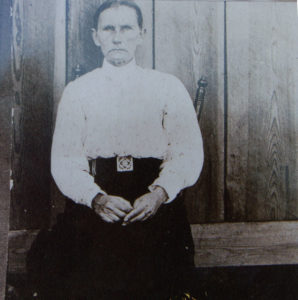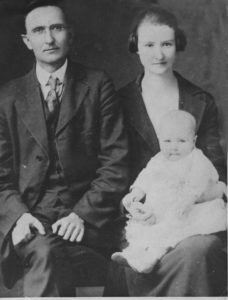My great-grandfather was William Melvin Langley (1881-1970). I’ve been tracing his line for years, but finally decided to add some historical context and put it someplace where I can share with family.
William P. Langley
William P. Langley was born in 1793 in Edgefield District, SC. I believe he descends from Langleys who were in Virginia since the early 1600s. I believe his father was John Langley, born on the James River, in Virginia, who was a Revolutionary War veteran.
The Edgefield District of South Carolina was created in 1785, and it is bordered on the west by the Savannah River. In current days, it is considered part of the Augusta, Georgia metropolitan area.
He married Nancy Blackmon in 1816.
They stayed in Edgefield almost 20 years and their first five children were born there:
- Elizabeth b. 1822
- Mary b. 1824
- Emanuel b.1830
- Margaret b. 1833
- John b. 1835
In 1837 the United States experienced a financial crisis that started a depression that lasted until the mid-1840s. The South was hit hard, especially the Cotton Belt.
That same year they ended up 250 miles away in Harris County, Georgia. Two daughters were born there:
- Caroline b. 1837
- Martha Mahala b. 1840
By 1842 they were in Alabama about 80 miles away in what would become Clay County. Their last four children were born there:
- Sarah Jane b. 1842
- William Melvin b. 1844
- James Burton b. 1847
- Andrew Jackson b. 1849
The Langleys took a common route to Clay County – it was called the Coastal Plain/Piedmont route. This migration route usually began in Virginia, then passed through the Carolinas to Georgia, and finally to Alabama. Most families using this route would stretch its traverse into six or seven generations. They normally spent 2-3 generations in the Carolinas and another 2-3 in Georgia, before moving on to Alabama. The Coastal Plain/Piedmont route largely consisted of English, Scott, Irish, Scotch-Irish, plus a few Germans and French.
Clay County lies in what was some of the last lands occupied by the Creek Indians before their removal west in 1832. Due to its hilly terrain and lack of rich land, early settlers to the area tended to be poor farmers. With the mountain land being unsuited for the economic production of cotton, and since it was held by the Creek Indians until the mid 1830s, this county was settled primarily by the less fortunate late comers. These frontiersmen owned very few slaves, lived in rough log cabins and had relatively small land holdings. When the log cabins finally gave way to homes built of sawn lumber, they remained small, simple and rough.
In August 1860 William P Langley’s farm was enumerated in the Southern Division of Talladega County (it would become Clay County in a few years).
He had 100 improved acres and 90 unimproved. The value was $400 and the farming machinery was worth $10. Their farm contained:
- 3 milch cows
- 11 sheep
- 8 swine
- 50 bushels indian corn
- 3 ginned cotton bales of 400lbs each
- 10 bushels peas and beans
- 5 bushels irish potatoes
- 60 bushels sweet potatoes
- 100lbs of butter
The economic golden era of the antebellum South largely bypassed Clay County. Clay County was primarily a land of “one horse” farms during those better times that existed in other parts of the state.
However, most of Clay County ancestors were staunch supporters of the Confederate cause when the American Civil War came. Clay County probably sent more men to the war per populace than many of those slave holding plantation areas nearby.
The Civil War started on April 12, 1861. William P’s sons John, Emanuel and William M. enlisted.
Civil War
Emanuel Langley

Emanuel was a private in Company G of the 31st regiment which was organized in Talladega in 1862 and moved to Tennessee. He enrolled in Talladega with Captain Chapman on April 20, 1862 and mustered in at Camp Goldwaithe on what is now Hwy 21, Talladega, AL on May 7, 1862.
They were then ordered to Mississippi and assigned to General Tracy’s Brigade in the Department of Mississippi and East Louisiana, it fought at Chickasaw Bayou, Port Gibson, and Champion’s Hill. At some point, Emanuel was captured and sent to a prison camp. He was on a list of prisoners leaving Cairo, Ill Oct 25, 1862 en route for exchange in Vicksburg, Mississippi.
The Siege at Vicksburg began on May 18, 1863 when Admiral David Porter had run his flotilla past the Vicksburg defenses in early May as Grant marched his army down the west bank of the river opposite Vicksburg, crossed back to Mississippi and drove toward Jackson.
After defeating a Confederate force near Jackson, Grant turned back to Vicksburg. On May 16, he defeated a force under General John C. Pemberton at Champion Hill. Pemberton retreated back to Vicksburg, and Grant sealed the city by the end of May. In three weeks, Grant’s men marched 180 miles, won five battles and captured some 6,000 prisoners.
During the long siege of Vicksburg 21 men from the 31st regiment were killed and Emanuel was one of them–he died on June 13, 1863.
Overall, the Confederate Army lost 32,697 at Vicksburg.
John Langley
John was in Company I of the same regiment as Emanuel (31st regiment, Alabama). He enlisted in Montgomery on February 21, 1862 with M.L. Woods, he enrolled in Captain Arrington’s Company on March 1, 1862 in Montgomery.
He was captured on July 4, 1863 in Vicksburg and paroled from Hospital 2 there. He had been under the command of General Pemberton.
He was then listed as having been captured again – this time by the 15th Army Corps on June 15, 1864 at Big Shanty, Georgia.
Big Shanty was the site of major fighting in the Battle of Kennesaw Mountain, part of the larger Atlanta Campaign. He was in prison camps in Nashville, TN and Louisville, KY and was received on June 24, 1864 at Rock Island Barracks. He died of pneumonia there on August 16, 1864 at age 29 and is buried in Rock Island Confederate Cemetery, Rock Island, Ill in grave number 1416.
William Langley
William M. was in Co. A 12th Regiment Infantry. He enlisted on April 26, 1864 in Talladega. He was in the Camp of instruction in Talladega in May, 1864. He ended up in “Battle’s Brigade”, meaning he fought under General Cullen Andrews Battle.

Battle’s Brigade became part of Lt. gen. Jubal A. Early’s Army of the Valley in the Fall of 1864 where William was injured while fighting in Virginia. He was given a certificate of a soldier’s furlough in September 1864 from General hospital in Lynchburg for 40 days back to Curry, Talladega as he was unfit for military service.
William returned to fight in Virginia and mustered out at the war’s end in April 1865. He returned to Alabama after the war at age 21. Two years later pensions were granted to Confederate veterans, but only those who had lost an arm or leg in the war so he did not qualify.
Post Civil War Clay County

During these early days, those citizens of Talladega and Randolph Counties were isolated from their court houses in Talladega and Wedowee by the mountains to their west and the Tallapoosa River to their east. They eventually won their bid for a separate county in 1866. Clay County was formed from a six mile section of eastern Talladega and a six mile section of western Randolph Counties. The donation of private land near the center of the new county determined the location of the county seat at Ashland.
During Reconstruction, legislators created new property taxes that forced farmers into indebtedness and tenancy and by the 1880s, Clay County had one of the highest rates of indebted farmers.
In 1869 William Melvin married Nancy Jane Hudgins, the daughter of Middleton Hudgins and Irena Reames also originally from Georgia (Meriweather County).
In 1870 William P. owned land in Ashland and no one in the family could read or write. William Melvin and his new wife lived next to William P.
William’s farm was enumerated as having:
32 improved acres
30 unimproved
1 horse
2 milch cows
3 working oxen
3 other cattle
7 sheep
5 swine
62 bushels of winter wheat
100 bushels of indian corn
½ bale of cotton
13 lbs of wool
Everything is worth $329
William P Langley died in 1872 at 79.
In 1880 his wife, Nancy B. owned 20 tilled acres and 45 “woodland and forest acres” in Ashland, Clay County. She had:
- One working oxen
- 1 milch cow and 1 calf dropped
- 40 lbs of butter were made on the farm in 1879
- 7 sheep and 1 lamb dropped
- 10 swine
- 6 barnyard poultry
- 40 dozen eggs produced in 1879
- 15 acres of indian corn and 100 bushels
- 7 acres of cotton planted and 2 bales
Everything was worth $390, including farm machinery
On the 1880 census, William M, Nancy Jane and their children lived in Chandler Springs, Talladega County – about 10 miles away from Ashland. William was a farmer and Nancy had been unemployed for 6 months and was sick with dispepsa.
William M. died the following year in April 1881 at 36, he left Nancy Jane behind who was two-months pregnant with their last child, William Melvin, Jr. :
- Middleton age 11
- Henry Jack age 10
- John Elisha age 8
- Nancy age 6
- James age 5
- Joshua “Dock” age 2
In 1891 the law was amended to grant pensions to indigent veterans or their widows. William M had been dead for two years and Nancy Jane was finally able to collect his pension. Emanuel’s wife Sarah also collected. They were allowed to make up to $400/year in order to collect.
In 1898, Nancy Jane’s daughter Nancy A. died at age 22.
Turn of the Century

In 1900 Nancy Jane was 57 and was living with William M Jr 18. They were renting in Marble Valley, Coosa County. They are both listed as farmers. I don’t know why they were suddenly in Coosa County and they didn’t appear to stay there.
Still in Ashland, Nancy B. was 102 and living with her daughter Elizabeth age 77, never married. They lived next to her son, James Langley and his family. I assume that Nancy B died that same year.

By 1901, Nancy Jane and William, Jr were back in Clay County.
In pension records, she said she owned:
- 40 acres in Clay County, Alabama $100
- 1 mule $15
- 1 cattle $15
- 1 household and kitchen furniture $15
- No pigs, guns, jewelry, vehicles, and farming tools
Total worth $170
In 1904, Nancy Jane’s eldest son, Mid Langley died at 34.
The railroad came through the county in 1907 bringing large logging operations such as Kaul Limber Company of Hollins, and the discovery of large graphite and other mineral deposits, and the economy improved somewhat.
In 1910 Nancy Jane was 60 and William was 28 and they lived on Talladega Road in Precinct 12 (unincorporated) Clay County. Nancy could not read or write. They lived next to Martha Hudgins, Nancy’s sister-in-law and her kids.
In 1918, William (age 37) married Susie Rayfield (age 17), daughter of Milburn Rayfield and Fairby Martin. He was living in Renfroe working on a farm.

Their first baby was born in 1919 – Willie Mae.
In 1920 Nancy Jane (age 70 ) lived with William, Susie and their baby Willie Mae at 413 Court Street, Talladega. They rented and William was a dry goods salesman. In the following years, they had:
- Emma Lee born 1921
- Howard born 1922
- Robert born 1924
- Agnes born 1925
- Melvin born 1928
In 1930, William and Susie lived on Sylacauga Road, District 13, Talladega County. Their rent is $12.50/month. William is listed as a collector for rentals. They are listed as living with:
- Willie M Langley Age 10
- Emma L Langley Age 9
- Howard Langley Age 7
- Robert Langley Age 6
- Agnes Langley Age 3
- Melvin Langley Age 1
Mary Faye was born that year and Melvin also died that year – before he turned 2.
 In 1932, William’s mother Nancy Jane died at 82. William and Susie had their 7th child, Billy Roy.
In 1932, William’s mother Nancy Jane died at 82. William and Susie had their 7th child, Billy Roy.
In 1934, they had their last child Bobby Joe, but he lived less than a year.
They lived at 509 Duke’s Village, Sylacauga in 1935.
Susie died in 1936 at the age of 34, William was 55 and left with:
- Willie Mae 17
- Emma Lee 15
- Howard 14
- Robert 13
- Agnes 12
- Mary Faye 6
- Billy 4
In 1940 they were still at 509 Duke’s Village. William was a time keeper for a WPA Street Project his salary was $694/year for for 52 weeks of work. Howard (17) worked at a cafe and grocery store – he worked 12 weeks in 1939 and made $48. Robert (16) was listed as a new worker and no salary was reported.